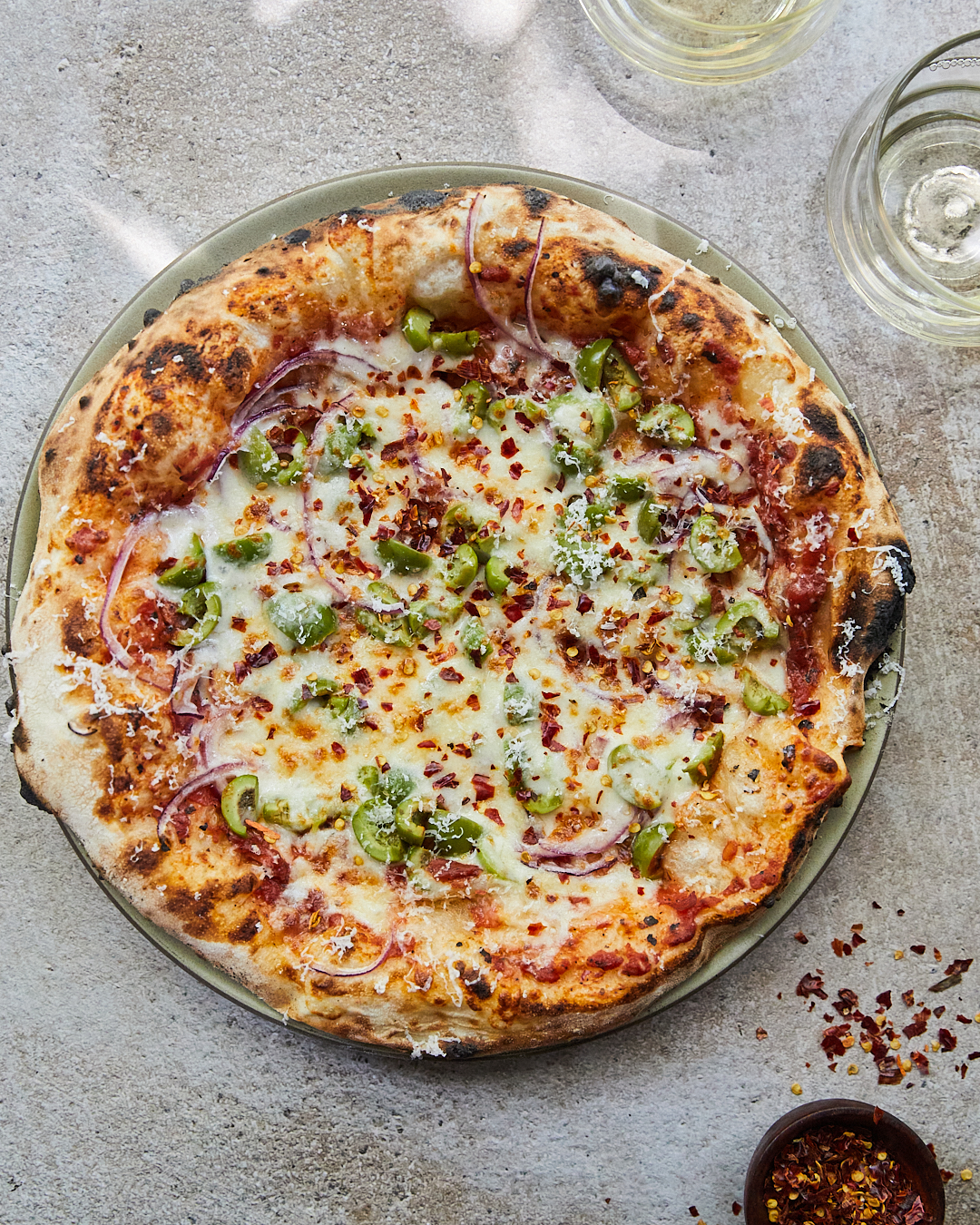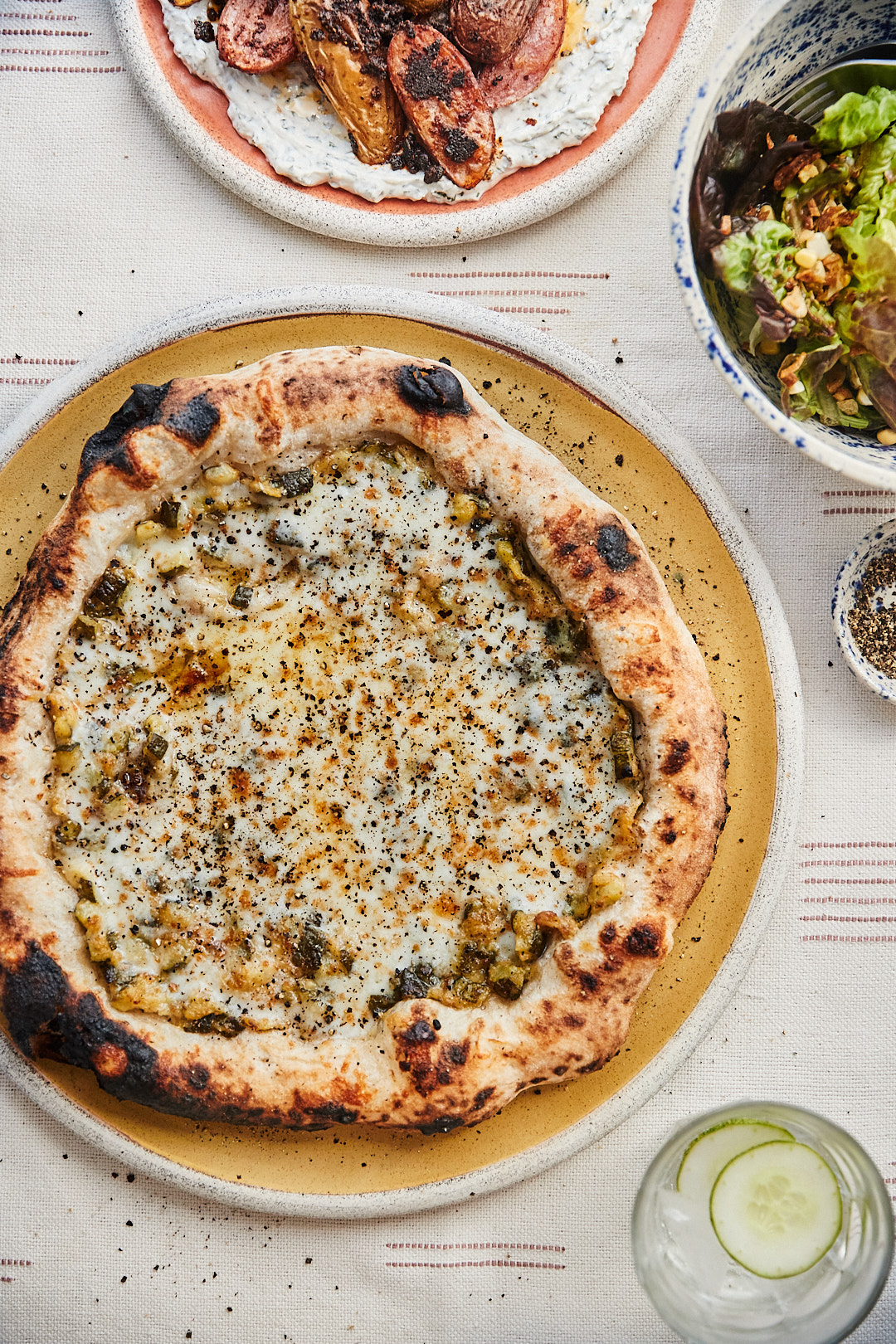
This is a post that was originally created for Casual Zine.
Pizza has become a weekly tradition in our house while being at home over the past year. It’s what I look forward to making each week. It’s also the thing I get the most questions about, so I figured it was time to put a bit of it to paper.
For starters, I’m not an expert. Each week I’m learning and playing around with different flours, dough hydration, pizza oven temperature, and toppings. But, things turn out pretty tasty, so below is a rough go at what I do with links out for videos I find helpful (because there’s a lot of nuance to pizza dough, and when you get it, it’s incredible). This post is just the base pizza- I’ll do another post with topping ideas and things I’ve done.
For the dough base
I’ve been making a variation of the recipe for the same-day dough from the book Flour Water Salt Yeast by Ken Forkish. The recipe in the book says it yields five dough balls, but where I’ve landed is cutting the recipe in half (500g flour) and yielding 3, 12” pizzas. I used to make the full recipe (1000g of flour) every other week and freeze half, but I found I just like the feel of the fresh dough better. It’s worth it to me to make the dough each week and is perfect for a family of 3-4 with a bit of leftover pizza.
You can also find wonderful sourdough recipes (I’d recommend this one) if that’s your jam. Ideally, it will be my jam one day- I have a hard time babysitting sourdough and remembering to feed it in time to make dough.
For the dough, I weigh out 500g of flour, 370g to 420g of 95˚F water, 10g of kosher salt, and 1g of instant yeast. Ken’s recipe has a bit lower hydration level for the dough (350g), but I nearly always use some portion of whole-grain flour.
My current levels have been about 80% freshly milled wheat (usually soft wheat like Chiddam Blanc or Wit Wolkoring) and 20% bread flour (either King Arthurs or Cairnspring). The soft wheats don’t have the same gluten strength as a hard wheat, so the 20% bread flour is balancing that deficit. For this level flour balance, I use 400g of water. If I do a portion of hard wheat, I push the hydration level closer to the 420g level. Wheat, especially freshly milled, is a bit more thirsty, and so the higher hydration keeps the dough feeling soft and workable. You can find the wheat flours I talk about at Grist + Toll or Capay Mill.
For mixing the dough
I follow Ken’s method pretty closely, and again, would highly recommend picking up the book for detailed instructions. Weigh the flour in a large container and weigh salt and yeast in separate small containers. Next, weigh the water and pour about two tablespoons over the yeast, and stir. Pour the remaining water over the flour and combine with your hands until most of the flour/water are incorporated—cover for 20 minutes.
After the flour has hydrated, make dimples on the top and sprinkle the salt over. Stir the yeast and pour over the dough as well. Then, begin stretching upwards and folding the edges of the dough over the salt/yeast mix. Then, use the pincer method (Ken has a good video explaining this process much better than I could do in writing), repeating this process until everything is well incorporated. Finish by shaping the dough into a ball and cover with a silicone cover or plastic wrap.
Important note: when stretching the dough, whole wheat doesn’t stretch near as far as all-purpose or bread flour. The dough should never tear, so be a bit more gentle with the whole wheat dough. And if you have no clue what I mean by stretch and fold, Ken explains it above, but here’s another helpful post/video as well.

For resting of the dough
After about 60 minutes, when the dough has spread to fill the bottom of the container, the dough gets one more fold into a tight ball. Wet your hands and follow the same folding method for above. After this, the dough just gets to chill until double the volume. I usually look for air bubbles at the top and a nice jiggle to the dough. Figuring out timing can take some experimenting to figure out what’s best.
Once the dough is ready, tip the dough onto a floured surface and divide/shape into three balls. This, too, has a process, and I’d recommend watching this video (and again, if using whole wheat-heavy doughs, use a lighter touch).
Once your dough balls are shaped, place them on a floured plate or tray, cover them again with silicone or plastic, and place them in the refrigerator. The dough can now chill in the refrigerator until you’re ready to use it (up to two days). Just be sure to pull the dough from the refrigerator about 45 minutes before cooking to warm the dough a bit.
For shaping the pizza dough
And finally, shaping the dough because this too is very important. There are a few different methods for stretching the dough. The essential takeaways for this are keeping levity in the rim of crust and making sure the bottom of the pizza is thin and even. I’m not a pro at this, so for this, I give you another video (or I highly recommend searching for New York Pizzaria videos on Youtube because they are fun to watch).
I stretch the dough as I make each pizza. So stretch, top, bake, repeat.
For cooking the pizza
I use my Ooni pro. Do you need a pizza oven to make great pizza? Not at all. Is it a hell of a lot of fun? Yes, yes it is.
You can also use your oven and a cast iron pan. I heat oil in the pan on the stovetop, slide the assembled pizza into the pan and cook over medium (to medium-high) until the crust starts to puff and set. From there, I transfer into an oven preheated to 450˚F and let it bake the rest of the way. Resist the urge to pull the pizza early- the cheese should be bubbly, and the crust should be golden.
For reheating leftover pizza
Heat a skillet with a lid and drizzle enough olive oil to cover the bottom of the pan. Heat over medium-ish heat, place slices in the pan and cover with a lid. The crust gets a bit crisp, the cheese melts, and it’s much better than a microwave.

